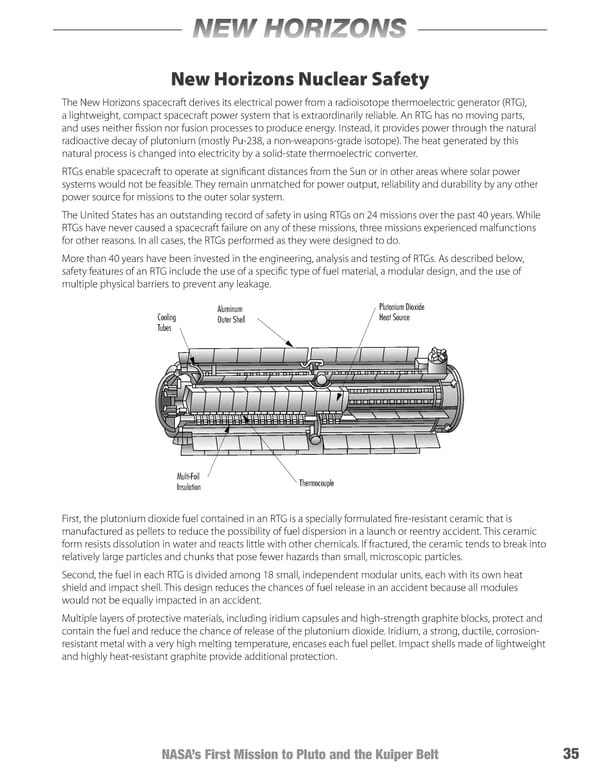NEW HORIZONS New Horizons Nuclear Safety The New Horizons spacecraft derives its electrical power from a radioisotope thermoelectric generator (RTG), a lightweight, compact spacecraft power system that is extraordinarily reliable. An RTG has no moving parts, and uses neither fission nor fusion processes to produce energy. Instead, it provides power through the natural radioactive decay of plutonium (mostly Pu-238, a non-weapons-grade isotope). The heat generated by this natural process is changed into electricity by a solid-state thermoelectric converter. RTGs enable spacecraft to operate at significant distances from the Sun or in other areas where solar power systems would not be feasible. They remain unmatched for power output, reliability and durability by any other power source for missions to the outer solar system. The United States has an outstanding record of safety in using RTGs on 24 missions over the past 40 years. While RTGs have never caused a spacecraft failure on any of these missions, three missions experienced malfunctions for other reasons. In all cases, the RTGs performed as they were designed to do. More than 40 years have been invested in the engineering, analysis and testing of RTGs. As described below, safety features of an RTG include the use of a specific type of fuel material, a modular design, and the use of multiple physical barriers to prevent any leakage. �������� ����������������� ������� ����������� ����������� ����� ���������� ������������ ���������� First, the plutonium dioxide fuel contained in an RTG is a specially formulated fire-resistant ceramic that is manufactured as pellets to reduce the possibility of fuel dispersion in a launch or reentry accident. This ceramic form resists dissolution in water and reacts little with other chemicals. If fractured, the ceramic tends to break into relatively large particles and chunks that pose fewer hazards than small, microscopic particles. Second, the fuel in each RTG is divided among 18 small, independent modular units, each with its own heat shield and impact shell. This design reduces the chances of fuel release in an accident because all modules would not be equally impacted in an accident. Multiple layers of protective materials, including iridium capsules and high-strength graphite blocks, protect and contain the fuel and reduce the chance of release of the plutonium dioxide. Iridium, a strong, ductile, corrosion- resistant metal with a very high melting temperature, encases each fuel pellet. Impact shells made of lightweight and highly heat-resistant graphite provide additional protection. NASA’s First Mission to Pluto and the Kuiper Belt 35
 New Horizons Page 46 Page 48
New Horizons Page 46 Page 48